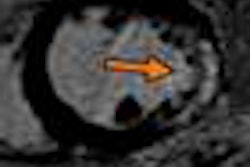Dear AuntMinnie Member,
Anyone who's prone to intense migraine headaches knows how debilitating they can be. However, findings on MRI may offer some hope for sufferers of this painful malady, according to new research published online in Radiology.
A surface-based MRI method to measure cortical thickness revealed that migraine headaches may be related to brain abnormalities present at birth and other abnormalities that progress over time, an Italian research team found. This information could eventually pave the way for effective treatment, according to the researchers. Features editor Wayne Forrest has our coverage, which you can find by clicking here.
Speaking of headaches, Canadian researchers reported this week in JAMA Internal Medicine that more than 83% of requests for head MR scans for headaches were appropriately ordered in a retrospective study. But the researchers say they uncovered "substantial overuse" in the ordering of lumbar spine MRI, with more than half of requests judged to be inappropriate or of uncertain value.
What else did they find? Click here for our coverage of the paper, or visit the MRI Digital Community at mri.auntminnie.com.
NCBC coverage
The National Consortium of Breast Centers (NCBC) meeting is in full swing in Las Vegas, and we are featuring coverage of several presentations this week in the Women's Imaging Digital Community.
With the advent of breast screening programs in the 1970s and 1980s, more and smaller cancers began to be uncovered, including "preclinical" lesions such as ductal carcinoma in situ (DCIS). But does DCIS need to be treated?
That question still doesn't have an easy answer, as it remains unclear which DCIS lesions will progress to invasive cancer. But overdiagnosing some DCIS lesions is the price to be paid for detecting early invasive cancer, according to Dr. Melvin Silverstein of Hoag Breast Care Center in Newport Beach, CA.
Get more of Dr. Silverstein's perspective on this challenging issue by clicking here.
While breast centers face a number of challenges in dealing with healthcare reform, reimbursement pressure, and evidence-based medicine, the best approach is to reach out to form patient care teams with other providers and to track performance, according to a presentation by Dr. Gary Levine, also from Hoag Breast Care Center.
Click here to learn about other actions breast centers can take, in an article by associate editor Kate Madden Yee, or visit the Women's Imaging Digital Community at women.auntminnie.com.




.fFmgij6Hin.png?auto=compress%2Cformat&fit=crop&h=100&q=70&w=100)




.fFmgij6Hin.png?auto=compress%2Cformat&fit=crop&h=167&q=70&w=250)











